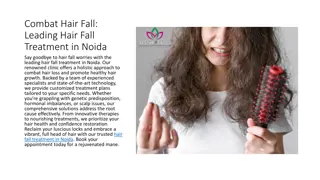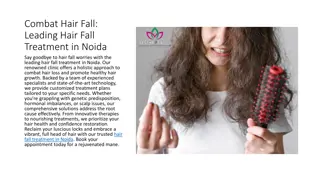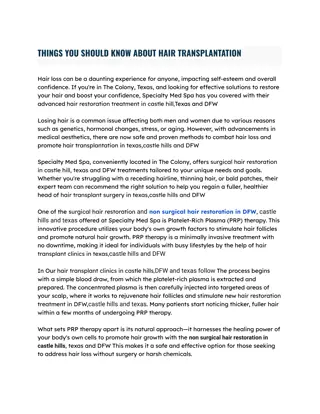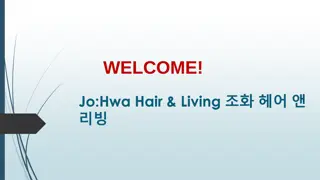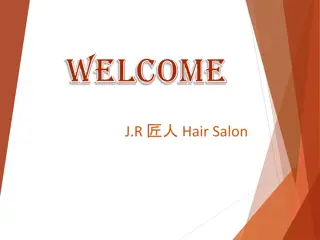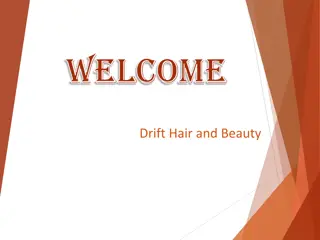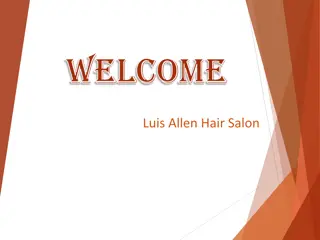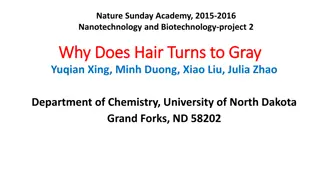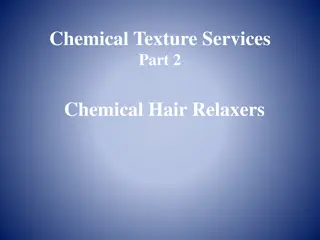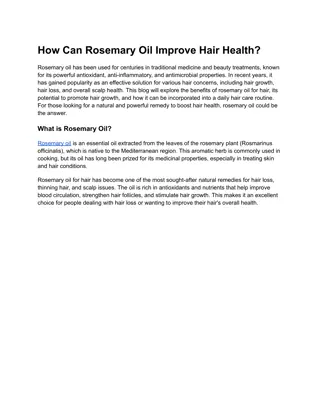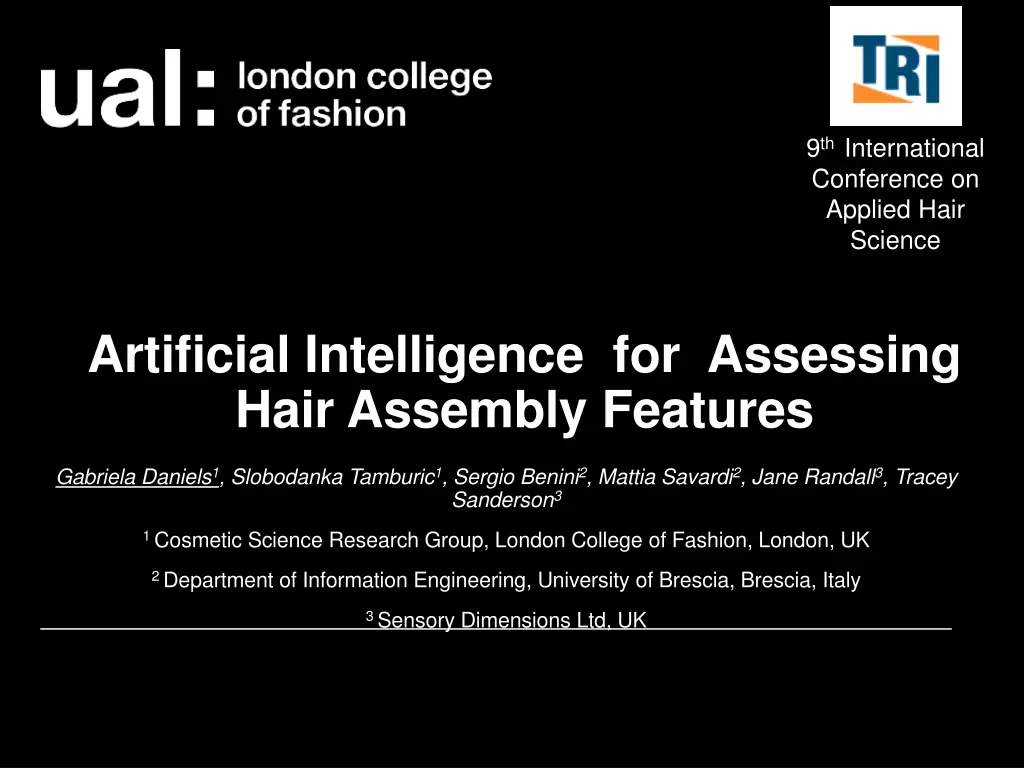
Innovative Research on Hair Science and Artificial Intelligence
Explore the groundbreaking research at the 9th International Conference on Applied Hair Science, focusing on applying computer vision and machine learning to quantify the effects of haircare treatments and analyzing hair assembly features. The project aims to bridge gaps in the field by leveraging AI algorithms for hair analysis, using the Figaro tresses database and conducting sensory assessments to compare human and AI outcomes.
Download Presentation

Please find below an Image/Link to download the presentation.
The content on the website is provided AS IS for your information and personal use only. It may not be sold, licensed, or shared on other websites without obtaining consent from the author. If you encounter any issues during the download, it is possible that the publisher has removed the file from their server.
You are allowed to download the files provided on this website for personal or commercial use, subject to the condition that they are used lawfully. All files are the property of their respective owners.
The content on the website is provided AS IS for your information and personal use only. It may not be sold, licensed, or shared on other websites without obtaining consent from the author.
E N D
Presentation Transcript
9th International Conference on Applied Hair Science Artificial Intelligence for Assessing Hair Assembly Features Gabriela Daniels1, Slobodanka Tamburic1, Sergio Benini2, Mattia Savardi2, Jane Randall3, Tracey Sanderson3 1 Cosmetic Science Research Group, London College of Fashion, London, UK 2 Department of Information Engineering, University of Brescia, Brescia, Italy 3 Sensory Dimensions Ltd, UK
Machine learning and hair What has been published so far? Work on hair recognition and classification of hair styles from images in the wild [1] and hair shape predictions [2] Fig. 1. Processing chain from hair detection to style classification Where are the main gaps in the public domain? AI has not been used for hair assembly property analysis No publicly available data set 2
Study objectives Objective 1: to apply computer vision and machine learning techniques to quantify the effects of haircare treatments on hair assembly and to identify correctly whether unknown tresses were treated or not. Objective 2: to explore and compare the outcomes of the human assessment with those of the artificial intelligence (AI) algorithms. 3
Methods: image dataset creation Figaro tresses database: n=1080 images, available via Mendeley dataset and Data in Brief [3][4] 0 +45 -45 4 Fig. 4,5,6,. Images of the same hair tress (bleached) taken from the three different angles.
Project stages Decide on the principles and structure behind the training data set, including the Expected Theoretical Behavior (ETB) of hair Produce the training data set of images Machine learning Hair detection and analysis of the training data set Validation tests for the classifying algorithms Analysis of data set features and comparison with the ETB Image analysis Visual paired difference test, comparison with ETB and image analysis Online paired image test, comparison with ETB and image analysis Sensory assessment Fig.2. Project workflow 5
Materials Methods: hair treatments and image generation Caucasian virgin hair tresses (n=120), fine medium brown hair, length=10cm, weight=3g Photographs of tresses @ T0 Half of the sample (n=60) was kept as virgin hair; half of the sample (n=60) was bleached lightly with a commercial bleaching product No treatment After the application of two consecutive treatments Photographs of tresses @ @T1 Commercial shampoo and conditioner (volumising and conditioning) were used for treating all hair tresses After the application of one more treatment Photographs of tresses @T2 Expected theoretical behavior: The treatment will cause volume increase, decrease in alignment and reduction of flyway. The virgin and bleached hair will display the same effects, but the magnitude in bleached hair will be higher. Fig.3. Workflow representation of the image dataset generation 6
Methods: machine learning A training dataset was created using 70% of each image subset (virgin and bleached hair). Features for analysis: Volume (Global & Local Hair volume) and Alignment (Histogram of Gradients- HOG) [5] as, in combination, these provide information on the hair assembly responses to a volumizing but also conditioning treatment Fig. 7. Example of tress sub division in thirds for the computation of the Local Hair Volume Two validation tests were conducted using 30% of images (unseen): Time order tests - could images of the same tress from two unknown treatment points be correctly ordered? Timepoint recognition test - could a tress image from unknown treatment point be assigned to the correct treatment points Fig. 8. Example of HOG extraction 7
Methods: sensory and online tests Sensory and online tests included three questions, asking the participants to assess: tress volume, straightness and flyaway. Hair presented suspended from a bar, under controlled conditions Visual paired difference visual test: t0 vs t2 Na ve assessors, n=50 Online paired image comparison test: t0 vs t1, t0 vs t2,t1 vs t2 Hair images taken at 0 presented via Qualtrics (SAP,USA) Na ve assessors, n=100 Fig.9. Summaries of the sensory human assessment 8
Machine learning test results Treatment order test: Two images of a tress representing two time points should be correctly ordered Example: tress A comes from a time point before tress B; over 80% accuracy Timepoint recognition test Example: unknown tress is correctly allocated to its timepoint More challenging; higher accuracy when T1 and T2 were grouped together Fig. 10. Confusion matrices. Correct results in bold 9
Results: AI analysis of volume and alignment Bleached hair: Volume: GHV reduction at t1* and t2 vs t0 Alignment index: alignment increased by 7% and 4% for t1 and t2 vs t0 Virgin hair: Volume: GHV reduction at t1* and t2* vs t0 Alignment index: alignment increased by 5% and 4% for t1 and t2 vs t0 Volume change between treatment time points and t0 Key: Global HV=0 Upper HV=1 Middle HV=2 Lower HV=3 Time points Time points Fig. 11. Hair volume analysis of the virgin hair subset Fig. 12. Hair volume analysis of the bleached hair subset 10
Results: paired difference test Table 1. Results from the visual paired comparison test, n=50 Virgin hair t2 Bleached hair t2 Question t0 p-value t0 p-value Which tress is more voluminous? Which tress is straighter? 0.016 32 0.032 33 17 18 39 0.000 18 0.032 11 32 Which tress has more flyaway? 22 0.240 31 0.059 28 19 Treated hair at t2 has less volume and is straighter* than untreated hair at t0 (both virgin and bleached hair) Flyway** result is borderline for bleached hair The results are not in line with the ETB but are in line with the AI analysis Fig.13. Presentation of the hair tresses for paired difference test * =hair straightness has been used as the closest possible away to describe good alignment in human terms ** = flyaway, defined as individual fibers separation from the bulk of the assembly, was not included in the AI analysis; however, it corresponds to conditioning 11
Conclusions This study highlights the usefulness of AI for hair tress assessment, as it could include hair features which are difficult to define and assess individually by humans. It also provides more sophisticated overall assessment of the hair assembly appearance. Human assessments based on a 3D-view of the hair corroborate the AI assessment. Human assessment of hair conducted from one viewpoint only is not sensitive to the more subtle shape and volume effects resulting from shampoo and conditioning treatments. 12
References: [1] U. Muhammad, M. Svanera, R. Leonardi, S. Benini, Hair detection, segmentation and hairstyle classification in the wild, Image and Vision Computing, 2018, 71, pp.25-37 [2] M. Zhang, Y. Zheng, Hair-GAN: Recovering 3D hair structure from a single image generative adversarial networks, Visual Informatics, 2019 3(2) pp.102-112 [3] M. Savardi, G. Daniels, S. Tamburic, U. Muhammad, S. Benini, Figaro-tresses: a dataset for evaluating hair assembly features before and after cosmetic treatment (v2020), Mendeley Datasets [4] M. Savardi, G. Daniels, S. Tamburic, U. Muhammad, S. Benini, Figaro-tresses: a dataset for evaluating hair assembly features before and after cosmetic treatment, Data in Brief, 2020, 31 [5] Learn OpenCV, https://www.learnopencv.com/histogram-of-oriented-gradients/ (Accessed on 2020.07.20) Acknowledgements The authors wish to acknowledge the contribution of the students from the MSc Cosmetic Science at London College of Fashion for conducting the hair tress treatments and image acquisition and Dr Umar Muhammad for his initial contribution to the AI investigation


